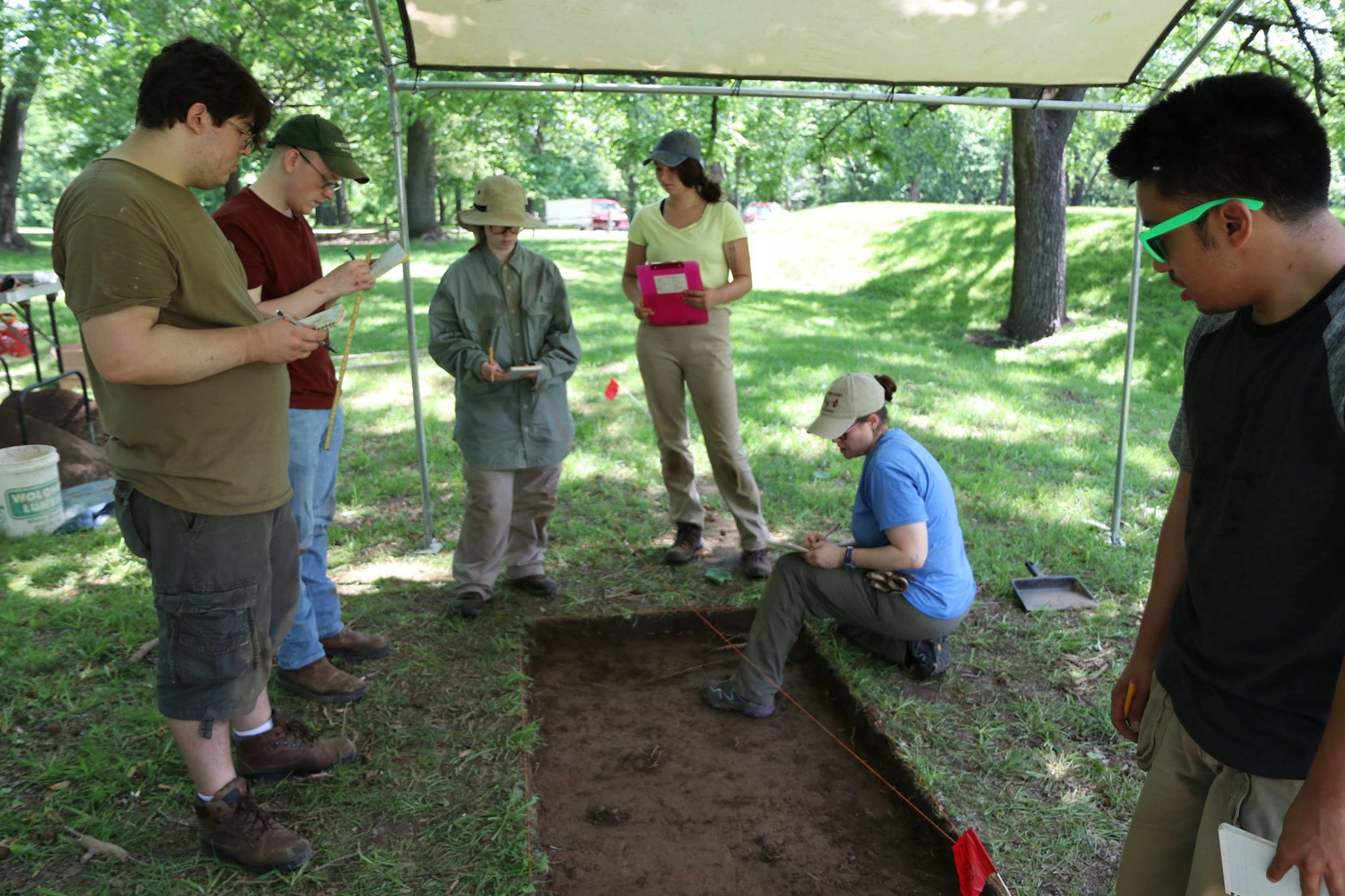
Mapping it out -- Jessi Spencer (seated), a graduate assistant in anthropology, teaches students how to excavate and map a test unit. (Photo provided)
May 31, 2018
Archaeological field school discovers a previously unknown American fort
CARBONDALE, Ill. — For decades, historians have believed that a single fort overlooking Kaskaskia, Illinois served as a fort for both French and American troops. But when Mark Wagner and his team of anthropology students began an archaeology field school class on the site last year, they made a startling discovery.
Standing tall on the site of Fort Kaskaskia is a sign that details the presumed story of a fort built by the French in the 1750s that later was renovated and occupied by the American Army in 1803. The most important event in the history of the short-lived American fort was a visit by the Lewis and Clark Expedition in 1803 to recruit 11 soldiers for their expedition to explore the American West. Finding this area to be of interest, Wagner and his team of SIU students conducted a test excavation within the French fort in 2017. After evaluating the recovered artifacts, it became clear to the professor that an American Army never inhabited the earlier French fort.
“When we did the archaeology here last year, we didn’t find a single U.S. Army artifact in that fort. And we found no evidence that the fort had ever been rebuilt,” Wagner, director of the Center for Archaeological Investigations, said.
Team finds American artifacts outside of the French fort
Operating on this theory, the team began researching adjacent areas of the park to see if they could discover the location of the American Fort Kaskaskia. Before very long, they began to unearth objects such as an American uniform button, brass neck stock clasp, early 1800s chimney brick and an American musket butt plate at another location north of the French fort. The location is approximately 300 meters away from the French fort and set on a slight uphill.
“The Americans also named their structure Fort Kaskaskia, and people jumped to the conclusion that they had rebuilt the earlier French fort. As it turns out, there are two Fort Kaskaskias, separated in time by 45 years. They are completely different,” Wagner said.
Future of this discovery
This year the team is back to further investigate both the French and American forts. Now that they know where the American fort is located, their goal is to learn more about the design and layout of this structure.
“It would take a number of years to get a full handle on this discovery. Now that we know where the fort is, the goal of our dig this year is to get a sample of artifacts to find out how the fort is oriented,” Wagner said.
Grant helps to fund students work
The 2018 SIUC Department of Anthropology Field School is comprised of 16 undergraduate and graduate students from SIU Carbondale, Murray State University and Northeastern University.
The program recently received small grants from the Lewis and Clark Heritage Trail Foundation and from the Southeastern Archaeological Conference. This funding allows the students to receive housing during the summer program and training from SIU faculty and staff. The grants also assist in the general excavation and discovery work.
Re-enactors to camp near newly discovered American Fort
History re-enactors will be portraying members of the Lewis and Clark Expedition and early French settlers for the “Public Archaeology Day” on June 9.
Members of the Lewis and Clark Discovery Expedition will be on hand to demonstrate the types of uniforms and equipment used by the Lewis and Clark Expedition. Living history actor Tony Gerard will also be present to give a historical portrayal of a French and American Indian trapper of the 18th century time period.
SIU Carbondale archaeologists will be available June 8-9 to give tours of their ongoing field school investigation of the American fort that was once visited by the Lewis and Clark Expedition. Tours will also be given near the French Fort, which is also contained in the park. The archaeologists will also demonstrate sensing equipment including ground-penetrating radar (GPR) and gradiometers that are currently being used in the work.
Archaeological field school continues work in Miller Grove
Students and faculty in the SIUC Department of Anthropology Field School will also be excavating in Miller Grove starting June 11. Miller Grove was a freed slave community that was established in 1840 in Pope County, and is now located in the woods of the Shawnee National Forest. The Shawnee National Forest has received a grant to bring a group of African-American students from Springfield to work with the 2018 SIUC Department of Anthropology Field School for two weeks.
